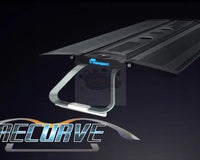Power consumption depends not on the size of the aquarium, but the electrical equipment that it’s running it, and how long it’s on for.
D-D Reef Pro 900, 300 watts Heater 2 x 45-watt LED lights (90 watts) and a 7 watt, 600lph pump. Total power consumption is 397 watts, although the heater will only be on for half the time, (sometimes a lot less,) and the lights on for half a day, maximum. Not 24 hours. That takes a realistic power consumption down to 192 watts on average throughout the day.
The average cost of electricity per kWh is 22p* (September 2022,) meaning that you pay 22 pence for every 1000 watts you use, every hour. So, at an average of 152 watts, a D-D Reef Pro 900 costs 3.34p per hour to run or 80p a day and £292.93 per year. And if you have the lights on for less time, or switch to the Helialux 1000 LED at 48 watts, you can halve the cost of lighting again.
The Aquael Leddy 60 comes with a 50-watt heater, 8-watt LED light and 4-watt filter. Total power consumption is 62 watts but halve the heater and lighting consumption because they are only on for an average of 12 hours out of 24, and average power consumption is just 31 watts. Multiply by 22p a kWh and the tank costs 1.33p per hour to run, 16p per day to run, and just £59.78 per year on your electricity bill. That’s economical tropical fishkeeping! Especially when compared to the average we spend on fuel per car per year, at £811.
How to lower aquarium running costs
If shopping for a new fish tank or equipment pays particular attention to the energy consumption of the air pumps, water pump, filters and lights, and compare with other similar output makes and models to compare their efficiency.
Live plants and live corals demand a fixed, bright photoperiod every day in order to photosynthesize, but even then, a 12-hour photo period can be cut down to eight or nine hours per day to save money, and the plants and corals will be fine under a slightly shortly daily duration.
How to save electricity in the home
It's quite likely that your aquarium is lit with energy efficient LED bulbs, so look to do the same around your home. Use LED bulbs to light your rooms and turn lights off when not in the room. Switch off TVs and computers when not using them instead of leaving them on standby.
Only fill the kettle with as much water as you need, fill the dishwasher, and wash clothes on cool whenever you can. Look for energy efficient fridges, tumble driers, washing machines and even TVs. Insulate your home and look into solar panels. Save money in all electrical areas and you'll get to continue enjoying the hobby you love.
*electricity prices may vary, and the above rates do not include standing charges and VAT.





